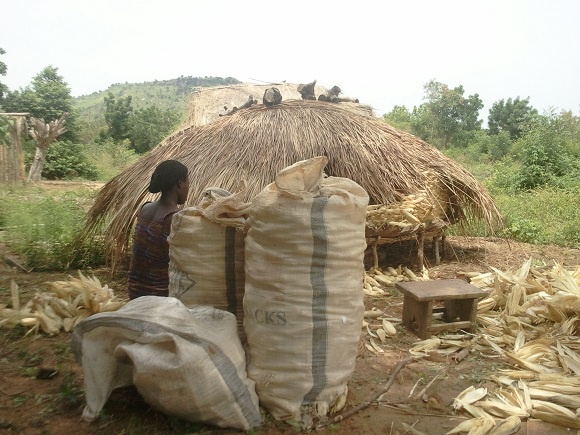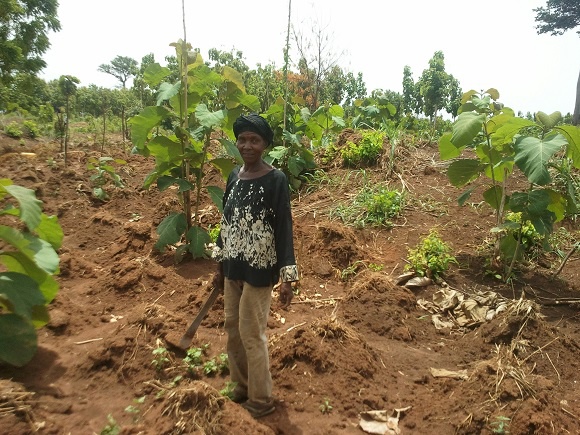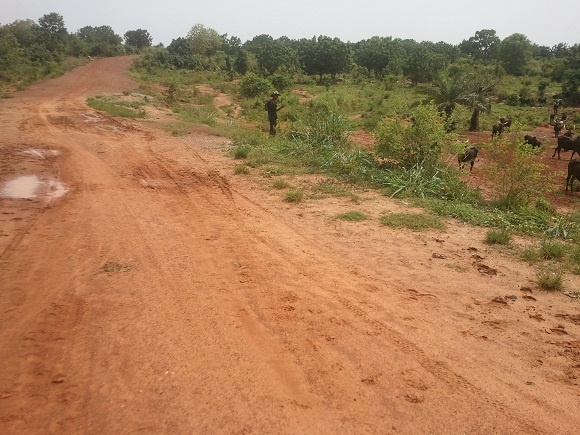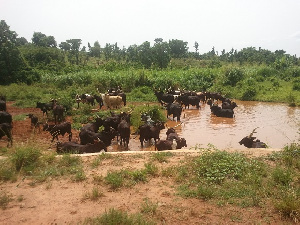Opinions of Thursday, 11 January 2018
Columnist: Kwabena Owusu-Ampratwum
Why driving Fulani herdsmen from Agogo will not resolve the crisis
The Fulani crisis at Agogo has once again is escalated to deadly levels and as usual, the government and security agencies are tough talking and vowing to rid the area of the nomadic herdsmen.
Frankly, this is nothing new, the only twist this time is that the herdsmen have stirred the hornet's nest by shooting three soldiers... we all know the soldiers don't take attacks on their own lightly, and they will hit back hard.
And do not be deceived, this is not the first time government will attempt to implement the 2012 Kumasi High court order for their eviction. A full operation was launched after that order in 2012 code named Operation Cowleg to drive the animals from nine villages mentioned in the court order. They moved them to an area beyond the vilages to an area on the Afram plains border between the Ashanti and Eastern region called Asomasu.
It only superificially resolved the crisis by transfering it to other parts of the country, primarily the Eastern region and before long, the troops had withdrawn and the herdsmen returned... and that is why today the crisis rages on.
This article retells the suffering of the residents of Agogo in a feature I produced during a similar crisis in 2011. It tells of my experiences reporting what I call the Fulani herdsmen menace and explains why driving the Fulani herdsmen away is not only unsustainable but will not solve the problem even if it is done yet again...
In September 2011, I found myself ushered, through my practice of journalism, into one of the most disturbing challenges facing natives of Agogo and the country’s food sustainability in general.
Tension had risen at Agogo in the Asante Akim North District of the Ashanti region and lives had been lost. My mission? To produce a documentary with a detailed analysis of the situation with contributions from all the stakeholders, Chiefs and residents, the Ashanti Regional Security Council, the nomadic herdsmen.
...and so it began with a tour on a motorbike of portions of the vast Afram plains, where the people of Agogo farmed to make a living.

A new dawn of fear
For about four years, going to the farm had become a nightmare for residents, including Maame Akosua who lived at Abrewapong, one of the surrounding villages. She had been tilling the land to make a living for 30years.
Life, for four years had been terrible for Maame Akosua. She could hardly make ends meet or feed her family because the crops she cultivated were repeatedly trampled upon and destroyed by roving Fulani herdsmen and their cattle.
There was a look of despair in her eyes, as she narrated how her watermelon farm was destroyed by cattle. It was practically impossible to plant anything because the animal will eat them before they mature.
Gazing into the clear skies of a hot and sunny afternoon in what was left of her farm, she recalled the peace and calm in the farm before the arrival of cattle in the area, "It was fun living when the Fulani were not here because we made gains from our farms, there were no animals or people to destroy them so it was really worth living here’’.
The arrival of Fulani and cattle at Agogo
The Fulani are the largest nomadic group in the world found in many countries in Africa Mali, Senegal, Ghana and others. They are traditionally nomadic, pastoralist, traders who herd cattle, across the vast dry hinterlands of West Africa.(credit Wikipedia)
Eighty-five-year-old Opanin Kwadwo Duro, Chairman of Agogo Residents Association witnessed firsthand the arrival of Fulani herdsmen in Agogo. "I remember very well in 1999, I came from a meeting at Konongo only to meet a large herd of cattle when I returned to Abrewapong" he began.
Opanin Duro continued that upon questioning the chief, he was told the cattle owners had made a request to the Traditional Authority for their animals and herdsmen to be settled in the area. They had been driven out of northern Ghana by ethnic conflict.

Consequently, he said, they were allowed to settle in the area under certain conditions...
1.They were to keep their cattle very deep in the forest, far from homes and farmlands.
2.The area containing the cattle must be fenced by the cattle owners to stop them going astray.
3.The cattle owners shall dig wells which will provide water for the animals to prevent them from destroying water bodies.
4. The cattle owners were to pay for any destruction to property and farm produce caused by their animals.
5. Every cattle owner will give one cow annually to the Agogo Traditional Council.
The chiefs were hopeful with these implemented, the town folk could live peacefully with the nomads, but this was not to be.
Broken Promises
Years on... none of the conditions had been fulfilled and the Fulani herdsmen had become the practical Landlords, patrolling the forest with AK 47 assault rifles and destroying everything in their path.
Maame Akosua became teary as she narrated how the herdsmen harvested her matured plantain to feed themselves and cut down the immature ones for the animals to feed on.
She was contemplating a move to the city, but was uneducated and old, finding a job will be next to impossible.
Its a daily war with the herdsmen and their cattle
For many like Maame Akosua, farming had become an extremely risky venture. Many had lost their lives or had been maimed for resisting the herdsmen's destruction of their farms.
Not far from Maame Akosua's farm was a watermelon farm with almost every crop damaged by grazing cattle.
The Fulani are nomads who settle wherever they find food for their animals. It appeared Stephen's watermelon farm was one of such conducive places to settle. They had constructed five mud hats to serve as their residence.
These mud huts were situated very close to Abrewapong, in breach of the conditions under which the herdsmen were admitted into the area.
In spite of his predicament, Stephen was actually "lucky" under the circumstances, because at least, he still had land to farm on, others were not so lucky, their lands had been completely annexed.
Seventy-year-old Emmanuel Kusi Gyebi told me he had lost his lifetime investment.He lived in another village, Mankara since his youth, and cultivated about 70 acres of teak.
Old and frail, he struggled to narrate how "One fateful day I decided to go and prune my teak trees only to realize the whole farm had been invaded by a large herd of cattle. The herdsman, brandishing pump action guns, told me to return home because the animals were resting under the shade of my trees, and this was the last time I stepped foot there, now I survive remittances from his children."
Visiting the danger zone
I needed to confirm some of the accusations being levelled against the herdsmen and their cattle, and the only way to do that was to venture into areas the residents claimed had been taken over by the cattle, no matter how dangerous it was.
I found that large tracts of land, which used to be farmed, had been turned into grassland for grazing. There were so many abandoned teak plantations with cattle followed by armed herdsmen enjoying the shade comfortably.
The motor rider who took me to the bushes warned me to hide any gadget because the herdsmen will shoot if they felt in any way threatened by our presence.
Waters being polluted
Not only were the besieged people of Agogo and surrounding villages losing farmlands and crops, their sources of water were also being polluted.
I came across river Bontre, which served many of the villages surrounding Agogo and the scene was no different from the pollution caused by galamsey. The river had turned greenish brown from cow dung.
Back to Maame Akosua’s farm, as she took me round to see what she cultivated, a herd of cattle suddenly appeared. This is exactly what she looked out for every day on the farm because the animals could attack if she stood in their way.
She said the herdsman was most probably hiding nearby looking at how we will react to the animals and if we tried to drive them away, he may shoot at us.
Not only had the herdsmen been destroying farms and the livelihoods of residents at Agogo and its villages, they had also been accused of sexually assaulting women.
I listened in astonishment as Maame Akosua narrated how a lady was allegedly raped right in front of her husband. "the lady was with the husband from the farm, the Fulani asked the man to take the baby and then he raped the woman at gunpoint, right in front of the man’’
Lack of confidence in Police
One of the first questions I asked the residents as we interacted was if the police were aware of their plight. Their response clearly indicated lack of confidence in the cops.
Maame Akosua said numerous reports to the police have yielded no response and the situation kept deteriorating.
The lack of confidence in the police was stressed by Stephen who said the police had done nothing about the incidents of farm destruction reported and accused them of bias towards the Fulani men.
Stephen who obviously was furious with the police at Agogo accused them of taking bribes from the cattle owners and the Fulani herdsmen, hence their reluctance to apprehend them when they attack locals.
He told me the police usually tell farmers they cannot do anything about reported attacks by the Fulani men if they( farmers) do not arrest and bring the armed Fulani men to the police station themselves.
The Agogo Traditional Council is also to blame
It is not only the police that the inhabitants cited for incompetence in efforts to resolve the crisis, the traditional leadership of Agogo were accused of selling land to the herdsmen without recourse to the adverse effect on natives.
Chairman of the Agogo residents association, Opanin Kwadwo Duro, said the residents had been pushing the traditional authorities to get the backing of the court to evict the herdsmen to no avail.
To find answers from the Traditional Council on why the court order had not been pursued, I caught up with the Registrar of the Agogo Traditional Council Joseph Nti at the Kumasi zoo. He confirmed some sub-chiefs had been illegally selling farmlands to the Fulani herdsmen.

The Alhaji Gruzah factor
However, he blamed one particular cattle owner for causing most of the problems. He was Alhaji Abdul Karim Gruzah, Chief Executive of King Faisal Football Club, one of five owners allowed to settle their cattle and herdsmen in the area by the Agogo Traditional Council.
I caught up with Alhaji Gruzah in his home. He also accused the residents of Agogo of assaulting the Fulani herdsmen leaving them with no option but to defend themselves.
He acknowledged he and other cattle owners had failed to go by initial agreements and added he was striving hard to ensure his cattle did not cause havoc to farmlands and property.
Alhaji Gruzah also believed he was being unfairly blamed because of his popularity and that he had often been cited in instances where cattle not belonging to him, caused damage.
Failed attempts
A lot has happened between the year 2011 when I produced this feature and the present time, 2017, but one fundamental thing remains, the people of Agogo still suffer at the hands of herdsmen and the suffering of Maame Akosua, Stephen, Opanin Duro and others still continue.
In 2012, after waiting for months without any action by the Traditional Council, the residents of Agogo, represented by the Member of Parliament for Asante Akyem North Kwame Anyimadu-Antwi, secured an order from the Kumasi High Court for the eviction of the herdsmen and their cattle from Agogo and nine other surrounding villages.
Operation Cow leg
On the orders of the High Court, the Ashanti regional security council launched for the second time Operation Cow leg. A joint police-military task force with the mandate to remove the herdsmen and their cattle as directed by the court.
With a base camp at the Agogo community centre, the force deployed to the villages and drove the cattle and the herdsmen out of the nine villages to the outskirts of the village of Abrewapong.
Nine-day wonder
The Operation Cow leg as a matter of fact temporarily resolved the issue at Agogo by creating another in other parts of the country. The Fulani herdsmen were driven to the back and beyond a hill near Abrewapong called Asomasu.
This area was not fertile ground for the animals because there was no grass, it was more arid with thorny plants and shrubs and so the herdsmen struggled to feed the cattle.
They then pushed further into parts of the Eastern region in search of pasture for the cattle, in the process coming into contacts with farming communities there and wreaking havoc on their produce. The menace at Agogo was therefore merely transferred to the Eastern Region, but never resolved.
Following fierce struggles with some farmers in the Eastern region, some of the nomadic herdsmen began to return to Agogo after some months when the task force had withdrawn... the problem was back to square one.
The Herdsmen and cattle are going nowhere.
The complexities of the situation at Agogo goes beyond just cattle being in the area. The Fulani have taken the flack all the while because what is not often discussed is who owns the cattle.
The herdsmen are mostly caretakers in charge of cattle owned by Ghanaians. This owner range from the ordinary to the most powerful. In fact, many of the politicians, policemen, military brass and security capos who are called upon to arrest the crisis, have thousands of cattle in various parts of the country, all under the care of "Fulani" herdsmen.
How are they able to acquire the sophisticated weapons such as AK 47 assault rifles and pump action guns? My interaction with some of these herdsmen over the years I have followed this case reveal they are armed by the owners of the cattle for the protection of their investment.
The solution may be costly but worth doing
When I heard the Ashanti Regional Minister Simon Osei-Mensah literally declare war on the herdsmen with a firm promise to drive them away from Agogo following the recent shooting of some soldiers by the nomads, my first question was...drive them to where?
Make no mistake, the herdsmen have forcefully annexed a lot of farms belonging to the residents of Agogo and this has impacted heavily on the production of plantain in the country. The Agogo area used to produce a substantial part of our plantain needs before the onset of the crisis. Yes, they have to be driven away from those farms because the land is not for them and the landowners need them to make a living.
But then again... where will they be driven to?
The herdsmen at Agogo arrived in 1999, and for nearly a decade after their arrival, they lived in harmony with the residents until about 2010 when major conflicts began to arise.
A lot of factors contributed to the conflict. The numbers of the cattle soared as many more herdsmen and cattle than were legally permitted under the agreement with the Traditional Authorities came in. Also as the population of the town increased, residential development pushed farmer deeper into the Afram plains to areas previously unfarmed.
These and other factors have brought the cattle closer to the human population within the past 10years.
The solution does not lie in just driving the herdsmen and the cattle away from the Agogo area, they will simply end up in other parts of the country and transfer the problem there.
What the nation has to do, is to begin a policy of rearing cattle in enclosures and growing fodder to feed them. Presently issues arise in the dry season when the grasslands of the Afram plains dry up during the harmattan season and the herdsmen roam with the animals in search of food.
There is enough land in the Afram plains to keep the animals and grow grass to feed them. If this is done, hay can be made from the excess grass during the rainy season to feed the cattle in the dry season, even without irrigation, and the business will be profitable.
Until we consider this and possibly other options, the crisis at Agogo may never be resolved.
Entertainment










